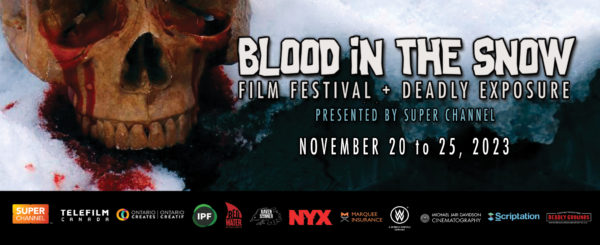
Blood in the Snow, a film festival dedicated exclusively to Canadian horror, returns for another year of fresh terrors.
[Read more…]The curated portfolio of film journalist Joe Lipsett
by Joe Lipsett

Blood in the Snow, a film festival dedicated exclusively to Canadian horror, returns for another year of fresh terrors.
[Read more…]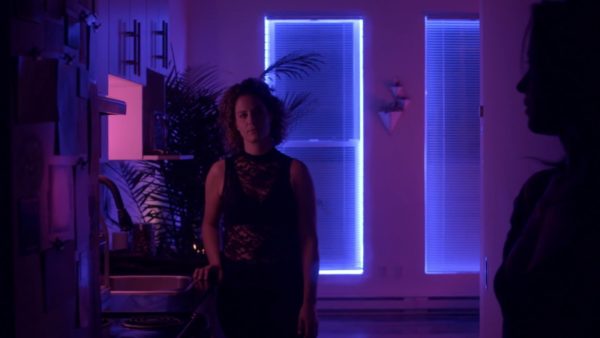
Montréal Dead End is an adventurous anthology feature that is steeped in the geography of one of Canada’s most gorgeous cities. The self-proclaimed “no budget” horror film created by 18 different directors takes several different approaches that helps to set it apart from its anthology counterparts and while, like its peers, it’s not always successful, it’s worth checking out just to see how all of the pieces play together.
It’s traditional for anthologies to use a bracket storyline to link the various entries together or provide some kind of thematic through-line. Montréal Dead End opts more for the latter approach, but intriguingly chooses to intersperse the ongoing storyline throughout the film. The film’s opening introduces a noxious green gas escaping from a sinkhole in the middle of the city and the remainder of the film explores the endless stream of terrors and monsters that arise in the mist’s wake (zombies and cannibals, mostly) in different parts of the city.
As the film progresses, it is revealed that the gas is tied to a forthcoming apocalypse that can only be prevented if the Guardian and the Archivist (Jérémie Earp-Lavergne) read from a powerful spell book within 24 hours of the gate opening. These segments tend to feature encounters between the Guardian and an agent of darkness with their own agenda (the Baron of Montréal North or the Priestess of Outremont, for example), but they’re rather repetitive and, most disappointingly, the resolution of the bracket storyline (ie: the climax of the film) occurs far too quickly and is resolved in an underwhelming fashion.
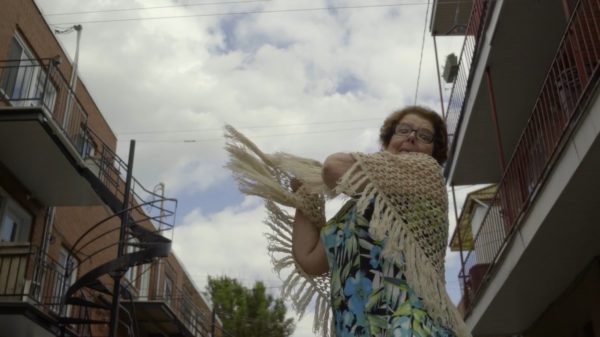
The other issue with Montréal Dead End is that the quality of the shorts vary dramatically. Because there are so many filmmakers involved, many of the 15 segments are quite short; at times this proves to be a minor blessing, but more often than not the need to cram in more ends up cutting off a promising story. Not unlike The ABCs of Death, the sheer number of shorts overwhelms the proceedings, so much so that they bleed together and become difficult to distinguish from one another. It also makes the 87 minute long film feel much longer than it actually is.
Thankfully there are several hidden gems. Many of the shorts that lean into comedy fare best (possibly because it’s easier to deliver a punchline than develop a mood, build tension and pay off a scare in the same amount of time). Among the strongest shorts are:
Several of the more horrific shorts are also enjoyable, but too many lean on familiar trappings: cannibals and/or zombies. One nearly silent short set in the The Village starts out promisingly: a pair of girlfriends fight about one’s wandering eye in a gorgeous purple neon-lit dance club. A strange man follows them home and lurks outside of the window as the envious philanderer first resists, then initiates sex, culminating in a physical attack. The association of carnal longing and food is subtle and effective, but the short has barely begun before it’s over. Contrast this with a meandering silent short about an old woman who is recruited for a bath by a group of feral children in the woods that is interminable.
Clearly not all of shorts are made equal.
Montréal Dead End plays the Blood in the Snow Film Festival Sat, Nov 24 at 9:30pm EST.
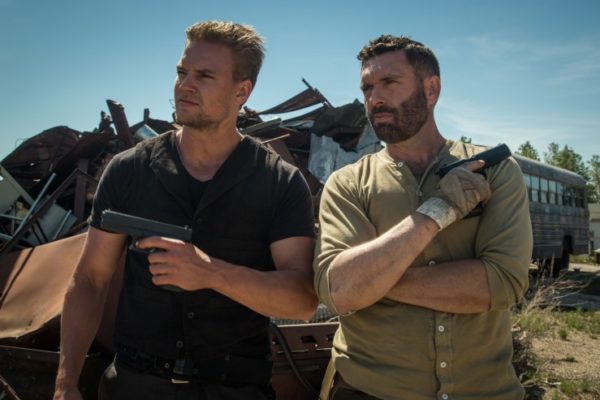
Opening this year’s Blood in the Snow film festival is director Lowell Dean’s Supergrid, a loving homage to dystopian road movies like George Miller’s Mad Max series:
SuperGrid is set in a near future where mining conglomerates have turned Canada into a wasteland. Two brothers must travel the same road that claimed their sister’s life in their quest to deliver mysterious cargo. En route they must contend with road pirates, rebel gangs, and each other.
Quick Review:
You know what you’re signing up for when you buy a ticket to SuperGrid. This is a film that dutifully checks all of the action movie checkboxes:
The fact that T.R. McCauley and Justin Ludwig’s script hews so closely to conventional tropes of the genre could be seen as disappointing, but Canadian action films remain a rarity so this Saskatchewan-shot production feels both ambitious and unique. Considering the minuscule $1.2M budget, Dean delivers some impressive visuals, particularly in regard to the futuristic dystopian world-building.
The actors are well-cast, particularly leads Leo Fafard (as older brother Jesse) and Marshall Williams (as impetuous younger brother Deke). Tough girl North (Natalie Krill) and Owl (Daniel Maslany, brother of Orphan Black star Tatiana) steal the show as Overwatch agents, while Fei Ren is enjoyably over the top (albeit a little broad) as hissable leather-clad hench woman, Guan Yin.
The Bottom Line: SuperGrid fails to offer anything new to the dystopian road movie subgenre, but it handles the expected tropes in a confident and enjoyable fashion.
https://www.youtube.com/watch?v=-5XHdmQuSkk
SuperGrid screens Thursday, Nov 22 at 9:30pm at The Royal. The film opens in theatres Dec 14.
by Joe Lipsett
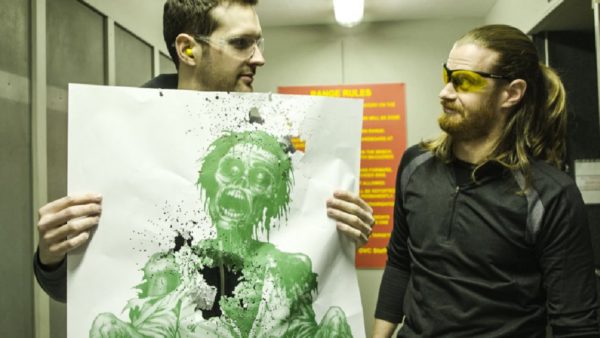
On its surface, Fake Blood has all of the trappings of any other found footage horror film. The film is a cautionary tale about two twenty-something filmmakers – Brad and Mike – who make low budget horror films. They’ve received minor acclaim and think little of the broader impact of their work until one day they receive a video of two men re-enacting a scene from their film, discussing how best to dispose of a corpse.
Not unlike most found footage films, the proceedings are presented as fact (ie: the two directors are the directors of the film and they use their own names). The video they receive sends the pair into a talespin as they ponder their responsibility as filmmakers for inciting (or is it inspiring?) violence in their audiences. And so begins a trip down the rabbit hole as they investigate the nuanced details of their own work: how long could a deadly fight actually last? How life-like is their low-budget gore compared to real wounds? And what is it really like for victims of violent crime?
These questions drive the “plot” of the film, which mixes found footage and true crime documentary tropes to create something inherently new. The guys eventually find themselves in well over their heads when the investigation leads them to a mob hitman named “John”, witness protection and eventually a murder, but these plot points are less captivating than the ideas that Fake Blood raises and the means by which it raises them.
Questions about life imitating art and vice versa have long been a part of the dialogue around true crime and horror films. There’s a history of the latter being based on real life serial killers and, in recent years, killers rationalizing, justifying and copying violent films for their own purposes. Fake Blood exposes this is a series of talking head interviews wherein Brad, Mike and their actors discuss films that are linked to real life violent events, as well their first exposure to film violence and how they interpreted it. Interspersed with these moments is footage of films such as The Matrix and Natural Born Killers. This documentary angle is hardly revelatory, but it brings the discussion to the fore in anticipation of the more meta(commentary) elements to come.
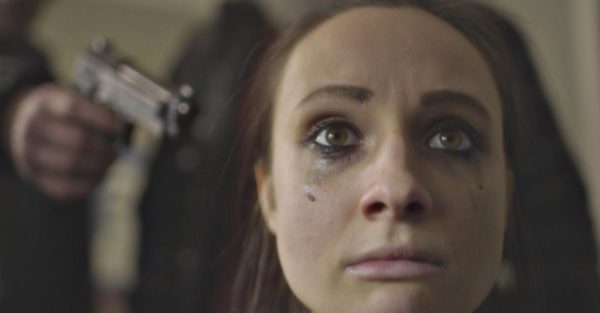
As the “plot” points involving “John” deepen and the threat of violence against the filmmakers escalates, the pair delve specifically into the details of his crime. As they pore over the casefiles and conduct web research, their discoveries are re-enacted by actors in true crime docuseries fashion, complete with staccato editing, stark lighting, slow motion and enhanced sound effects. The result is evocative of any number of true crime series on cable (Cold Case Files; I Survived, etc) that have gained popularity for sensationalizing real life crime stories.
And then – just when audiences are sucked into the violent re-enactment – either Brad or Mike will loudly yell “Cut!” and the video will return to normal to remind us that we’re only watching a fictionalized version of events (which are being presented as real, but are, in reality, also fictional). It’s a double layer of deception that is incredibly effective at reinforcing the fact that we, as audiences, are also actively consuming these violent acts, buying into the gore and contributing in some way to the dialogue that Fake Blood is engaging in.
In this way, even if the particulars of the “case” that Brad and Mike end up embroiled in are mildly underwhelming, the ideas about craving and celebrating violence and who is ultimately responsible for depraved acts that may or may not spill out of the screen is fascinating. Couple that with the tools that (the real) Brad and Mike use to dig into it, and you have an incredibly smart and effective film that denies easy categorization: part true crime documentary, part found footage horror film and 100% worth watching.